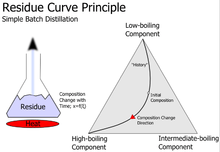Residue (chemistry)
In chemistry, residue is the material remaining after distillation or an evaporation, or to a portion of a larger molecule, such as a methyl group. It may also refer to the undesired byproducts of a reaction. Residue is very important in the world of chemistry. Residues of distillation are constantly analyzed for quantitative measures. For example, during the distillation of white wine, after ethanol has been extracted, water and sugar is the main ingredient of the residue. In this case, the residue is not undesired product. This is important because the residue can be consumed since it tastes very good in reality, almost embodying some sort of grape syrup. Also, the residues are tested for ethanol for the conclusiveness of the distillation.

Distillation residue is studied intensely. For example, the effects of chemical kinetics on residue curve maps for reactive distillation is a big area of potential study that is currently being underwent at University of Massachusetts. Because reactive distillation is not advantageous in every case, so there is a need for systematic methods to decide when this technique should be used. It is determined by analyzing kinetics of residue formation. This has many uses, for instance, this technique can be used for specific product removal. The study further itself on the effect of kinetics on residue curve maps, which does not need to be further addressed in this section.

Also, studies of chemical residues have huge implications on food toxicity. According to the Canadian Food Inspection Agency, food supply is probed for chemical contamination caused by chemical residue. For instance, in 2012, a total of 628 samples were collected and analyzed in dried food category (figs, dried dates, corn products, and nut products), and Samples were analyzed for residues using a multi-residue method that detects the Aflatoxins forms B1, B2, G1 and G2. Both the levels of the individual forms and the total aflatoxin levels were reported. Most of the samples (584/628 or 93%) did not contain detectable levels of AF. In another food category, residue seems to be causing a lot of toxins. In 2011, a total of 288 bottled water samples (Samples consisted of spring waters, mineral waters and purified waters from both domestic and imported origins.) were randomly selected and tested of bromate residue (a residual chemical compound that can be formed in bottled waters when sufficient levels of bromide are present in waters during disinfection via zonation). Bromide ions are naturally occurring compounds in water resulting from runoff, leaching or seawater intrusion. Bromate is considered to be possibly carcinogenic to humans. Chemical residue is a big problem in food health and safety. The FDA also has clear guidelines on the methods of testing of chemical residues that are possibly dangerous to consume.

In biochemistry and molecular biology, a residue refers to a specific monomer within the polymeric chain of a polysaccharide, protein or nucleic acid. For example, one might say, "This protein consists of 118 amino acid residues" or "The histidine residue is considered to be basic due to its imidazole ring." Note that a residue is different from a moiety, which, in the above example would be constituted by the imidazole ring or "the imidazole moiety".
Note the origin of this usage: during the process by which monomeric building blocks (e.g. amino acids) are strung together into a polymeric chain (e.g. a protein), some material (typically adding up to one molecule of water) is discarded from each building block, and only a "residue" of the building block ends up in the finished product.
For instance, a residue is an individual amino acid in a peptide chain.
References
"Drug & Chemical Residues Methods." FDA.gov. US. Food and Drug Administration, Apr.-May 2005. Web. Apr.-May 2013. <www.fda.gov>.
"Bromate in Bottled Water." Canadian Food Inspection Agency. N.p., Feb.-Mar. 2007. Web. 18 Apr. 2013. <http://www.inspection.gc.ca/>.
"2010-2011 Aflatoxins in Dried Fruits, Nuts and Nut Products, and Corn Products." Canadian Food Inspection Agency. N.p., Aug.-Sept. 2009. Web. 18 Apr. 2013. <http://www.inspection.gc.ca/>.
Baker, Lane. Exp-11 Kinetics of the Iodine Clock Reaction (pp. 1–12). Experimental Procedures / Appendices.